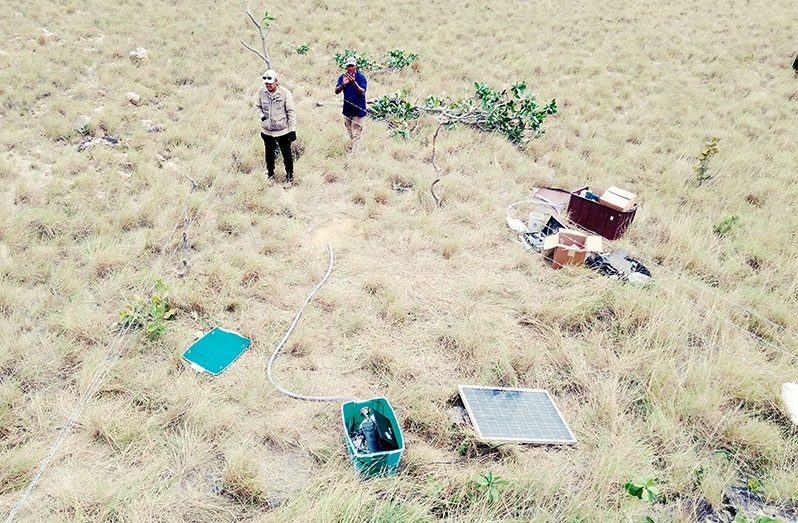–‘prelim’ findings focus on construction of houses in ‘Deep South’
THOUGH Guyana experienced a 5.7 magnitude earthquake since January 31, hundreds of smaller ‘quakes’, or ‘aftershocks’, have been occurring daily in southern Guyana and parts of Brazil, resulting in a multi-disciplinary team putting measures in place to monitor and study these aftershocks.
The team at reference consists of persons from the Civil Defence Commission (CDC), the Guyana Geology and Mines Commission (GGMC), the Ministries of Public Works and Home Affairs, and the University of São Paulo in Brazil.

Last week, the team travelled to the ‘Deep South’ Rupununi area in Region Nine (Upper Takutu-Upper Essequibo), where the epicentre of the earthquake was identified. The communities of Katoonarib, Sawariwau and Aishalton were among those more seriously affected. In these communities, cracks on the earth’s surface were observed, and a few buildings were damaged.
There, the team installed equipment to monitor seismic activity in four different locations: One close to the epicentre of the earthquake, and three in surrounding areas, thereby creating a seismic monitoring network.
“A seismic network is to record and study the aftershocks,” Professor at the São Paulo University, Marcelo Sousa de Assumpção explained during a virtual meeting, adding: “Most of them (the aftershocks) will occur in the same faults, and we can use the aftershocks to study the properties and the geology of the main shock (the January 31st earthquake).”
The professor explained that an earthquake occurs when the rocks, or faults, on the earth’s crust can no longer sustain the stress (or pressure) that it has been experiencing for a very long time. At that point, there is a sudden movement, known as a failure, that generated a very strong vibration.
He explained that sometimes, some parts of the fault may still have some stress to release, thereby resulting in the aftershocks. And this has been the case in the ‘Deep South’ area, where the fault running across the region has been releasing these aftershocks.
“The activity is decreasing slowly, but it is still recording tens and hundreds of small earthquakes every day,” the Professor noted.
During a recent visit to the community of Katoonarib, residents told the Guyana Chronicle that they experience these aftershocks between one to three times a day.
“We are every day alert to see if anything would happen, especially at night… Everyone here has houses with zinc and cement blocks, and so we would hear the tremors and wake up and wait for it to calm down before we go back to sleep,” the community’s Deputy Toshao, Floria Singh said.
FORESHOCKS
Meanwhile, the professor also noted that these monitoring efforts have allowed the team to discern that ‘foreshocks’ (the release of stress before the ‘main event’ or the January 31 earthquake) were felt in Boa Vista, Brazil, since December 25, almost one month before the earthquake itself.
With the monitoring system now in place, he noted that it is possible to study the characteristics of these foreshocks, or potential foreshocks, as a means of indicating that a larger shock will occur.
That early-warning system, however, will be difficult to institute, since it would require the equipment being installed in the four locations to continuously transmit data online. This is not done with the current system; instead, a team from the GGMC will have to travel to the areas and collect the data weekly.
The equipment will be operational for a few months, allowing for adequate monitoring of the aftershocks. And, in about two month’s time, equipment will be placed in a fifth location to bolster monitoring efforts.
Professor Sousa de Assumpção, however, noted that it may take a number of years, even a century, before another major earthquake is recorded here. He, however hastened to add that there is no guarantee that this would occur, as smaller earthquakes may occur before that time.
Moving forward, the Brazilian University will seek to cooperate with the GGMC and CDC to study aftershocks, interpret the ground cracks seen in Katoonarib and Sawariwau, and study whether there are other smaller faults nearby.
MODIFIED CONSTRUCTION
Additionally, the focus now is on the construction of houses in this ‘Deep South’ area, since the ‘adobe’ houses (houses made primarily of mud and clay) are the ones that were most affected by the earthquake. By contrast, those made of timber and concrete were not as affected, as was illustrated in a preliminary report prepared by representative of the Public Works Ministry, Heidi Gillette.
“If we can come up with a way to use the materials they have in the community; because that is what they use to build, then we can reduce the impact of the earthquakes,” Gillette emphasised.
Minister of Home Affairs, Robeson Benn, who is a trained geologist, conceded that while the houses at reference have “historical value”, the earthquake has illustrated that there needs to be an “upgrade of the housing construction” for safety reasons.
Similarly, Professor Sousa de Assumpção noted that it would be advisable for the local authorities to study the recommendations made, vis-à-vis construction, to reinforce these buildings. Furthermore, he advised that critical buildings such as schools and hospitals should be reinforced.




.png)









